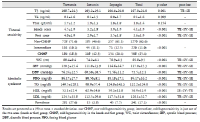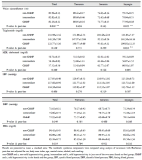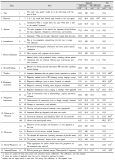Argonet WEB
- KOREAN
- ESCI, SCIE, KCI Candidate, SSCI, SSCI, A&HCI, KCI Candidate, A&HCI, KCI, SCOPUS
Vol.34 No.1

Abstract
ObjectivesThis study aimed to examine the differences in the distribution of metabolic syndrome(MetS) and cold hypersensitivity in the hands and feet(CHHF) according to Sasang constitution, and to determine whether CHHF and MetS have an inverse association.MethodsMetS and its components, CHHF, Sasang constitution data from 1,998 participants in the Korean medicine Daejeon Citizen Cohort study(KDCC) were obtained. The participants were divided into a non-CHHF(n = 1,270, 63.6%), intermediate(n = 220, 11.0%) and CHHF(n = 508, 25.4%) group according to the thermal sensitivity questionnaire. Sasang constitution was diagnosed by Korea Sasang Constitutional Diagnostic Questionnaire(KS-15). One-way ANOVA and the chi-square test were used for participants’ general characteristics and thermal sensitivity and MetS related factors. ANCOVA and logistic regression were used to compare the differences and the odds ratios(ORs) for MetS and its components.ResultsThe MetS and CHHF prevalence rates of the Taeeumin, Soeumin, and Soyangin were 27.6%, 3.8%, 7.7%, and 18.3%, 42.3%, 26.4% respectively. The ANCOVA for MetS components showed that the waist circumference was significantly lower in the CHHF group as compared to the non-CHHF group in total and Soyangin. The logistic regression for MetS prevalence showed that CHHF had a significant inverse association in total(OR = 0.611) and Taeeumin(OR = 0.521).ConclusionsThe MetS prevalence had the highest in Taeeumin, followed by Soyangin and Soeumin, while the prevalence of CHHF was highest in Soeumin, followed by Soyangin and Taeeumin. In addition, it was confirmed that CHHF and MetS had an inverse association independently.





Abstract
ObjectivesThe purpose of this study is to reevaluate the quality of reporting on case reports published in Journal of Sasang Constitutional Medicine (SCM) from June 2018 to December 2021, compared with January 2015 to May 2018.MethodsCase reports were identified by searching from archive on the website of society of Journal of SCM. We assessed the quality of reporting on them based on CAse REport (CARE) guideline.ResultsA total of 32 case reports was finally included for the assessment. Overall quality of reporting was improved compared to one of previous study. The median reported rate of ‘sufficiently’ reporting increased by 7.8% from 66.7% to 74.5%, while the one as evaluated ‘not sufficiently’ and ‘not reported’ decreased by 4.1% from 14.8% to 10.7%, and 3.5% from 21.4% to 17.9%, respectively. However, more than 50% of 32 case reports did not still report 5 items about intervention adherence and tolerability(96.9%), diagnostic challenges(93.8%), adverse events(87.5%), timeline(68.8%), and patient’s perspective on interventions(65.6%). Compared to the results of previous study, continuous attention is required for adverse events and changes in intervention in which the unreported rate increased by 18.3% and 6.3%, respectively. In addition, prognostic characteristics, patient’s informed consent, patient’s occupation, and keyword of ‘Case report’ and ‘Sasang (Constitutional) medicine’ should be sufficiently reported in the future.ConclusionsDespite the overall improvement in the quality of reporting, efforts to improve the quality of reporting should be continued by referring to well-reported cases reports previously published in Journal of SCM.






Abstract
ObjectivesThe purpose of this study was to enhance the understanding of Yin and Yang poison by examining and comparing the views of Je-ma Lee and the medicine scholars before Je-ma Lee, including Zhang Zhongjing.MethodsWe examined and compared the contents related to Yin and Yang poison in 『Essential Prescriptions from the Golden Cabinet (金匱要略)』, 『Donguibogam (東醫寶鑑)』, and 『Donguisusebowon (東醫壽世保元)』.Results and ConclusionIn 『Essential Prescriptions from the Golden Cabinet』, Zhang Zhongjing described the symptoms of Yin and Yang poison respectively, but could not suggested each prescription. In 『Donguibogam』, there were several prescriptions for Yin and Yang poison, respectively. In 『Donguisusebowon』, Yang poison belonged to the Soyangin and Taeeumin disease, Yin poison belonged to the Soeumin disease. Je-ma Lee emphasized that interior heat, which has grown suddenly should be controlled quickly for treatment of Yang poison in Soyangin and Taeeumin. And, in order to treat Yin poison caused by chronic course in Soeumin, Ginseng should be used a lot to help the Yang energy. Also, it is a better treatment to take the medicine ahead of time before the disease develops into Yin poison.



Abstract
ObjectivesThe purpose of this study was to reveal that Sasang constitution(SC) was associated with hypertension and pre-hypertension and could be a risk factor.MethodsWe introduced this study to educational personnel in D university in Daejeon, and 275 subjects joined this study. The SC classification was conducted with KS 15 questionnaire. The subjected measured the blood pressure with Jawon medical device automatically after 10 minute rest. The hypertension and pre-hypertension was classified by the guide of the Seventh Report of the Joint National Committee on Prevention, Detection, Evaluation, and Treatment of High Blood Pressure. The frequency analysis and T-test was used in general characteristics, and chi-square test was also used between SC and pre-hypertension and hypertension. Logistic regression was used to calculate the odds ratios (ORs) and 95% confidence interval (95% CI) for pre-hypertension and hypertension.ResultsThe number of Taeeumin(TE), Soeumin(SE), and Soyangin(SY) was 142, 71, and 61 respectively. There was significantly different in systolic and diastolic blood pressure among SC types(p<.001). The distribution of the normal group, pre-hypertension and hypertension group by SC types was significantly different (p<.001). The ORs of TE was significantly increased (ORs 4.039, 95% CI=2.019-8.082 in pre-hypertension and ORs 4.235, 95% CI=1.581-11.348 in hypertension) compared with SE(p<.001), and after adjusting gender and smoking habit, it was still significantly different(p<.001).ConclusionsIt is possible that SC, especially TE could be a risk factor both pre-hypertension and hypertension.






Abstract
BackgroundAdherence to healthy diet acts as a key role to modify sedentary lifestyle in real life setting. Constitution type of traditional Korean medicine has been prediagnosed to risk factors of cardiometabolic diseases. This study aims to evaluate the associations between body composition and healthy eating status in Korean adults by their constitution type.MethodsOf 4046 participants from Korean Medicine Daejeon Citizen Cohort study, Korean Medicine Daejeon Citizen Cohort (KDCC) study were included for analysis. Demographic, health-related behaviors and Korean Medicine (KM) type were surveyed based on a general health-related questionnaire. Anthropometric measurements and dietary factors by using Korean Healthy Eating Index (KHEI) were assessed only in the half of the original participants.Results50.8% of Taeeum was observed from eligible 1967 participants (66.7%, women). The highest KHEI score was observed in soyang group (52.0±0.3, p=0.006) compared to other two groups. In taeeum group, lower appendicular skeletal muscle mass (ASM)(%)(Taeeum: 38.7±0.1 vs. Soeum/Soyang: 39.2±0.1, p < 0.05), and higher percent of body fat (PBF)(%) (Taeeum: 32.9±0.2 vs. Soeum/Soyang: 29.0±0.2, p < 0.05) by the lowest tertile (T1) of the KHEI score, respectively. When the KHEI score increased by 1 point in taeeum group, a positive relationship was observed, which increased by 0.015% of ASM, however, a negatively related to in which body fat mass (BFM) decreased by 0.022 kg and PBF decreased by 0.024%.ConclusionCustomized nutritional management is required that could help maintaining physical health and diet by their constitution type.




